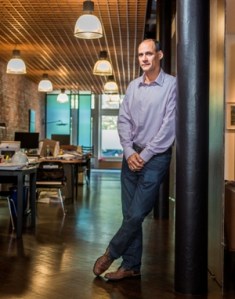The Bush Push: Tribeca Associates Founder Elliott Ingerman on Bush Tower
By Gus Delaporte September 24, 2013 9:00 am
reprintsLast week, TriBeCa Associates, a New York-based real estate firm, announced that it had agreed to acquire the long-term leasehold—for an undisclosed sum—on Bush Tower, a 30-story skyscraper built in 1918 for the Bush Terminal Company. To be henceforth known as 132 West 42nd Street at Bryant Park, the property will undergo an extensive renovation in the next 12 to 18 months, paving the way for the trophy asset to join the ranks of the neighborhood’s more recognizable glass towers. The project is one of a number that Tribeca Associates has in the pipeline, not the least of which is the Baccarat Hotel and Residences at 20 West 53rd Street, where sales are underway. Elliott Ingerman, founder and managing partner at Tribeca Associates, spoke with The Commercial Observer at the firm’s Tribeca office about current projects and his outlook for 2014.
 You have acquired the long-term leasehold on Bush Tower. Can you give some background on how you identified that opportunity?
You have acquired the long-term leasehold on Bush Tower. Can you give some background on how you identified that opportunity?
We looked at that property and identified that there was an ability—based on the transition of the southern side of that block—to increase the rents and increase the value of the building.
We approached a broker who had previously tried to sell the building for the Dalloul family, and I said, “Would you go to them directly and see if we can work out a transaction to buy the property?” We were unsuccessful but spent a lot of time with them. They then put the building on the market, and we bid again and again and again. We weren’t able to accomplish that differential—as well the market wasn’t able to meet their number.
We had developed a nice relationship with the family. We talked about doing joint ventures and other possibilities, and through those discussions we realized we had similar goals for the building. They had done a lot with the building. They’d bought it in ’83, and times were very different in Times Square. There were a number of clubs that were an eyesore, and they helped clean up the area. They have a letter from the police chief thanking them for helping to get rid of one of the clubs in 1984. They also did a lot of things to upgrade the building, and I think in this last push they needed someone who had that focus.
I think they were comfortable that we were the group that understood the building over the time we spent with them, which was over two-and-a-half years. They were comfortable with my vision and felt that I knew and cared for the building—maybe not as much as them, but almost. We then started working on a transaction, which turned into the long-term lease we have now.
What is your vision for Bush Tower? It has a great history, but it has also fallen behind the rest of the neighborhood.
When I look at the building, I see it in a very positive light. It is what it is—you’re not going to change that. It’s never going to be a glass tower, but that’s O.K. because it is beautiful in its own skin. What made us very positive about the building are its light and air, its ceiling heights and some of the authenticity. While it does sit in a glass tower neighborhood, not everyone wants to be in a glass tower, and I think that having a building that has these attributes is very beneficial from a leasing standpoint.
What we are going to do is accentuate the beauty of the building. The first thing we’re going to do is we’re going to change the façade. We’re going to add a little more glass, and, while the lobby was renovated three or four years ago—and they did a nice job—I think we’re going to redo that and try to make it like a jewel box. We are going to renovate the elevators, and then we are going to prebuild units that really accentuate the light, the air, the views and the ceiling heights.
When you look at the building, even though it’s a mid-block building, because of the plaza between Bush Tower and 1095, you actually get a ton of windows on the easterly façade looking east, which is as wide or wider than a double-wide street. It feels more like a corner building. The floor plates in the base, which are 15,000 to 16,000 feet, have 50 windows, and most corner buildings have 20 to 25 windows. The ability to put smaller spaces in line is terrific.
We also looked at the marketplace and felt there was a situation where the leasing velocity was very heavy in the under-10,000-foot market. It represented about 30 percent of the marketplace, while the availability was 10 percent, so there was something offline there. The building from floors 11 to 29 has floor plates of 2,500 to a little over 5,000 square feet, and to get a full-floor identity in that size range is very rare, especially on Sixth Avenue, which has very large, 2-million-square-foot corporate buildings. In the base, you can have full floors, or you can divide them up, because you have windows and because of the light and air. It gives us a lot of flexibility.



